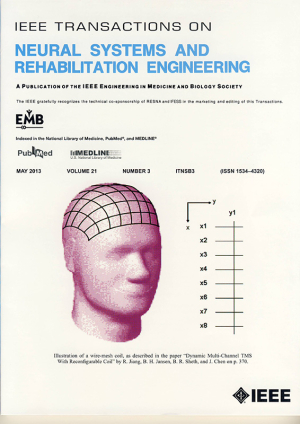Efforts to learn how and when particular areas of the brain work and work together should get a huge boost thanks to a new device under development at the University of Houston Cullen College of Engineering.
Ben Jansen a professor of electrical and computer engineering with a joint appointment in biomedical engineering, electrical and computer engineering faculty members Ji Chen and Bhavin Sheth, and Ph.D. student Ruoli Jiang have developed the concept for a “dynamic coil” that generates an electromagnetic field to stimulate different areas of the brain in practically any order, combination and timeframe. Their work is featured on the cover of the May 2013 issue of IEEE Transactions on Neural Systems and Rehabilitation Engineering.
The device is a far more advanced version of the present stimulus coil currently deployed in transcranial magnetic stimulation (TMS), a widely used technique for studying the brain.
In typical TMS research, an electric current is run through a metallic coil, creating a magnetic field. The coil can be placed on the skull to either induce or interrupt activity in the section of the brain that lies just below.
This technique, though, limits brain researchers to affecting only one section of the brain at a time, which is a major hindrance, said Chen. “If a researcher with a standard coil wants to see how different parts of the brain work together, he or she has to physically move the coil from one place on the skull to another. That’s slow and inaccurate and it really limits the usefulness of TMS.”
The dynamic coil solves this problem with a grid of conducting wires integrated into a mesh that is placed on the subject’s skull.
Using a computer interface, researchers will be able to program the device to generate an electric current at specific intersections of the wire grid. This will allow them to induce a magnetic field at practically any point on the skull and hence impact essentially any part of brain’s surface.
The biggest benefit of the dynamic will come from being able to program these fields to turn on or off in specific orders, combinations and times, Jansen said. “This provides the researchers with maximum flexibility when they want to study how different parts of the brain interact. All they have to do is program the dynamic coil to meet the guidelines of their experiment.”
Pre-set sequences of magnetic fields, for instance, could be used to study behavior, learning, rehabilitative therapy and much more, said Sheth.
“If you really want to study how different parts of the brain interact, you’ve got to be able to stimulate these sections one after the other, very quickly. The dynamic coil gives researchers the control to do that. This should be very useful for many different areas of neural research.”
